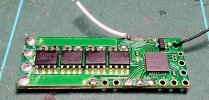maxi-model
UK/US/ROW steam narrow gauge railways 1:1
Many thanks Phil. However I am not sure I understand some your terminology - FET, logic level outputs (1,2,3,4 5,L,6,7,8)? What functions are they involved in ? I do not need/wish to control lights on off with rc - is that what you are proposing with your install suggestion ? Testing with meter, what is suppling the voltage ?
My inclination is to use fly leads off the battery terminal (nominal 13v) +/- to the +/- terminals on the buck. Set up buck's output voltage to 5v. Create circuit, with all on + buck output, return all to - buck output. Interpose switches on circuits for lights and smoke as required. Does this make sense ? Card will only be used for motor voltage control. Note white wire on card is not attached at one end to anything, what is its purpose ? Pictures, of now bare card and its supplied TX. Max


My inclination is to use fly leads off the battery terminal (nominal 13v) +/- to the +/- terminals on the buck. Set up buck's output voltage to 5v. Create circuit, with all on + buck output, return all to - buck output. Interpose switches on circuits for lights and smoke as required. Does this make sense ? Card will only be used for motor voltage control. Note white wire on card is not attached at one end to anything, what is its purpose ? Pictures, of now bare card and its supplied TX. Max












